Update: UP to have grading system in class 10 boards; Govt. for single board at all-India level for school education; Govt. plans independent panel to rate schools
Different media sources report on the idea of central govt. to reform school education system in India. Following is an excerpt from CNN-IBN:
Union Human Resource Development Minister Kapil Sibal has come up with a innovative idea to reform school education system and is planning to scrap the Class 10 board examination. Sibal not only wants to do away with Class 10 board examination but also set up an evaluation system based on percentiles.
"We need to de-traumatise it and reduce the burden on parents and children. We could, for instance, think of abolishing the Class 10 board exam. Why does a child need to appear for a board exam in Class 10 if he or she is continuing in the same school?" asked Sibal.
"I think we should not let the students and their parents go through this immense trauma at a such young age. I will be taking forward this proposal and will be discussing it with the state broads too. We already have NCERT recommendations on it and this not new. Many countries don’t have exams but have a different form of assessment. For Class 12, it is different. We need to have exams because the students will be going into graduate colleges, but for Class 10, why should we have percentages when we can have percentile," he added.
Sibal also said it this ministry will do its best to implement the Yash Pal Committee report within 100 days. The Committee headed by Professor Yash Pal had been set up to advise on Renovation and Rejuvenation of Higher Education and has recommended the establishment of a National Commission for Higher Education and Research (NCHER).
June 25th, 2009
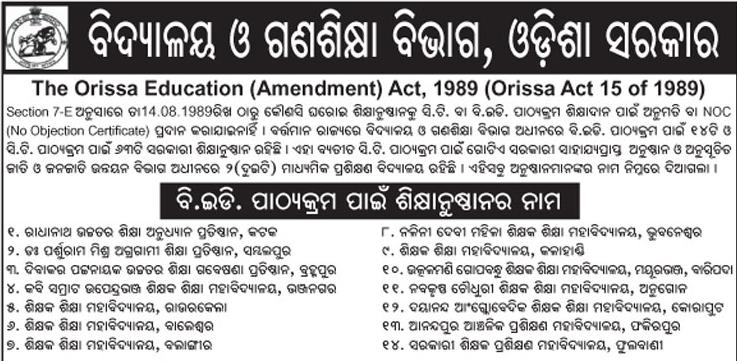
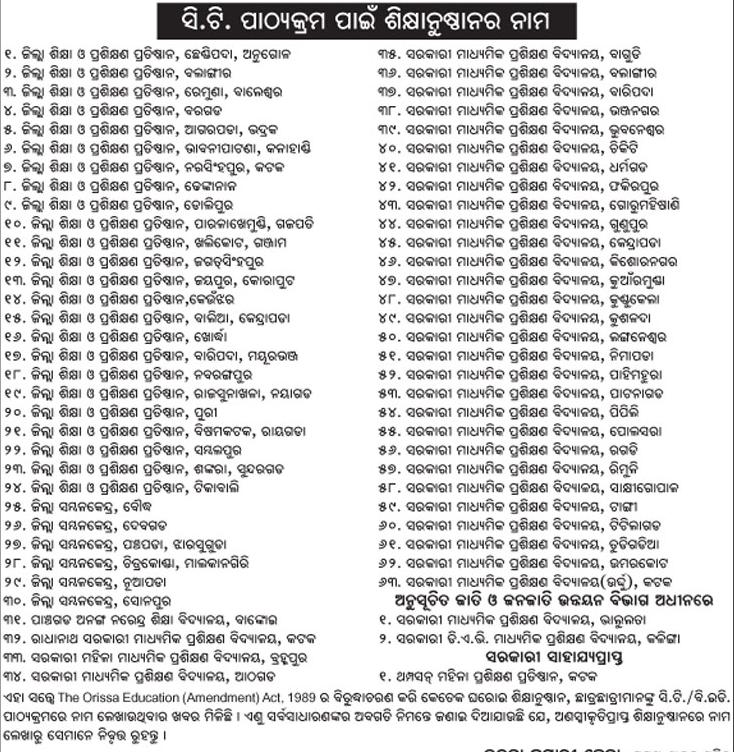
June 22nd, 2009
Following is an excerpt from a report in Times of India.
About 124 students of rural schools were felicitated by chief minister Naveen Patnaik on Saturday for their brilliant performance at the National Math Olympiad.
Shradha Ranjan Grahacharya, a Class IX student at Kanakpur in Jagatsighpur district, wants to be a scientist and do research in her favourite subject, algebra. Although mathematics as always been her favourite, she began to take greater interest in the field after she was selected for the Rural Mathematics Olympiad (RMO) in 2006 when she was in Class VI.
"After I was picked for the RMO camp, I started liking the subject even more. At the camp, teachers taught us some easy methods to solving difficult mathematical problems," said Shradha, who stood first in the Junior Mathematics Olympiad, 2008.
According to IMA director Swadhinananda Pattanaik, there is a lack of interest in mathematics among parents and teachers, especially in government schools in villages. Hence, the IMA has decided to make teaching of mathematics an interesting and fun-filled activity.
"In most classrooms, there is little opportunity to understand maths beyond the level of solving equations. Typically, students just memorize mathematical facts without actually understanding the subject," he said.
Encouraging the young mathematicians, chief minister Naveen Patnaik said, "The IMA’s efforts are commendable, especially the special programmes to prepare students for premier institutes like IIT and NISER. This is the only institute of its kind in the country. I hope it will spread its wings globally very soon".
Besides the 124 young students, 33 senior students who performed well in the Regional and National Mathematics Olympiad were also felicitated. IMA is also conducting summer camps for undergraduate and post-graduate students.
June 15th, 2009
Following is from http://timesofindia.indiatimes.com/Columnists/SA-Aiyar-An-open-letter-to-Kapil-Sibal/articleshow/4653435.cms.
| SWAMINOMICS |
Back to school: An open letter to Kapil Sibal
14 Jun 2009, 0031 hrs IST, Swaminathan S Anklesaria Aiyar
|
|
|
Dear Kapil Sibal,
… for truly inclusive growth we must focus on improving basic education for the poor and historically disadvantaged classes. Poor people send their kids to government schools, but hardly any teaching takes place there, and the teachers are protected from disciplinary action by powerful trade unions. No chief minister dares antagonize these unions. Richer students supplement schooling with private tuitions, but this is unaffordable by poor students, who end up functionally illiterate after years of schooling. Lakhs of crores spent on education are wasted.
School vouchers can be one way forward. Parents can get outright grants per child in the form of school vouchers, which are redeemable only for expenses in a government or private school. Vouchers will empower poor people through choice in schools, just as democracy empowers them through choice in politics. Competition with private schools will improve government schools, just as competition from private airlines and banks have improved service in government airlines and banks.
But teachers’ unions hate competition or accountability, and oppose school vouchers. They also point out that the results of school vouchers in western countries have been mixed. In some states in the US, voucher students perform no better than those in government schools. In Sweden, on the other hand, voucher students fare distinctly better.
But in those countries, government teachers actually teach. This, alas, is not the case in India. And so desperate urban slum families are pulling their children out of free government schools and sending them to private schools, at great financial sacrifice. These private slum schools are hardly of high quality, yet are better than government schools having highly qualified teachers but little teaching. The very fact that slum-dwellers are sending kids to private schools in large numbers is the best evidence that private schools are better, whatever may be the experience in the US or Europe.
In Delhi, the Centre for Civil Society has started a small project offering school vouchers worth Rs 3,600 per year to 408 children. An independent evaluation shows that voucher children perform better in standardized tests than comparable children in neighbouring government schools; that parents find the teaching and infrastructure better in private voucher schools than government schools; and that over half the poor beneficiaries will be forced to send their children back to government school if the vouchers are withdrawn. This shows that vouchers are badly needed by the poor, and yield better results too.
The Delhi scheme is tiny. Some chief ministers have sought other ways to try and scale up vouchers. In Rajasthan, the former BJP government sought to persuade government teachers to start private schools, for which students would be given vouchers. Unsurprisingly, this failed to find many takers.
So, Kapil Sibal, let me propose an alternative. You should launch a pilot project, making funding available to states who are interested, and scale up after removing the inevitable glitches. The project should offer school vouchers to urban children of disadvantaged minorities — Dalits, tribals and Muslims. Only urban areas have multiple schools within walking distance of every locality, and that is a necessary condition for real choice.
Teachers’ unions will oppose this idea too. But their opposition will be muted since the benefits are limited to a small, historically disadvantaged section of the population. Besides, the idea will be supported by vote-banks of Dalits, tribals and Muslims, all of whom are wooed by politicians. Chief ministers will find it worthwhile to take on trade unions only if they are compensated by support from substantial vote banks.
In the Delhi scheme, activists spread information about vouchers in areas with 12 lakh citizens, of whom 1.2 lakh applied for vouchers. The vouchers were awarded through a draw of lots to a lucky few. Although only 408 children benefited, the project enthused over a lakh households, a number high enough to qualify as a vote-bank, and so interest politicians.
Teachers will see this as the thin end of the wedge, and launch agitations. One form of compromise could be to offer vouchers at least to girls from Dalit, tribal and Muslim families. Even the most cynical unions may feel ashamed of denying benefits to the most oppressed gender among the most oppressed classes.
Kapil Sibal, your new government is committed to affirmative action for the historically disadvantaged. This can be an excellent launching pad for school vouchers. Do not waste the opportunity.
I have written about this approach in the past. I think its time has come. An interesting fact not mentioned in the above article is that in many private schools teachers are paid less but the students do much better. A good example is the Sarasawti Sishu Mandirs. (Lets us ignore the religious organization behind those schools.) So pumping money to primary education is by itself not enough; nor is the the "Right to education act." What is needed is the "Right to Choice of Education."
I slightly disagree with the suggestion that this has to start in the urban areas. i think pilots should also be done in rural areas as the fact that government will be providing vouchers might actually encourage private organizations to open schools in those areas. With PMGSY the private schools in rural areas may even provide transportation.
June 14th, 2009
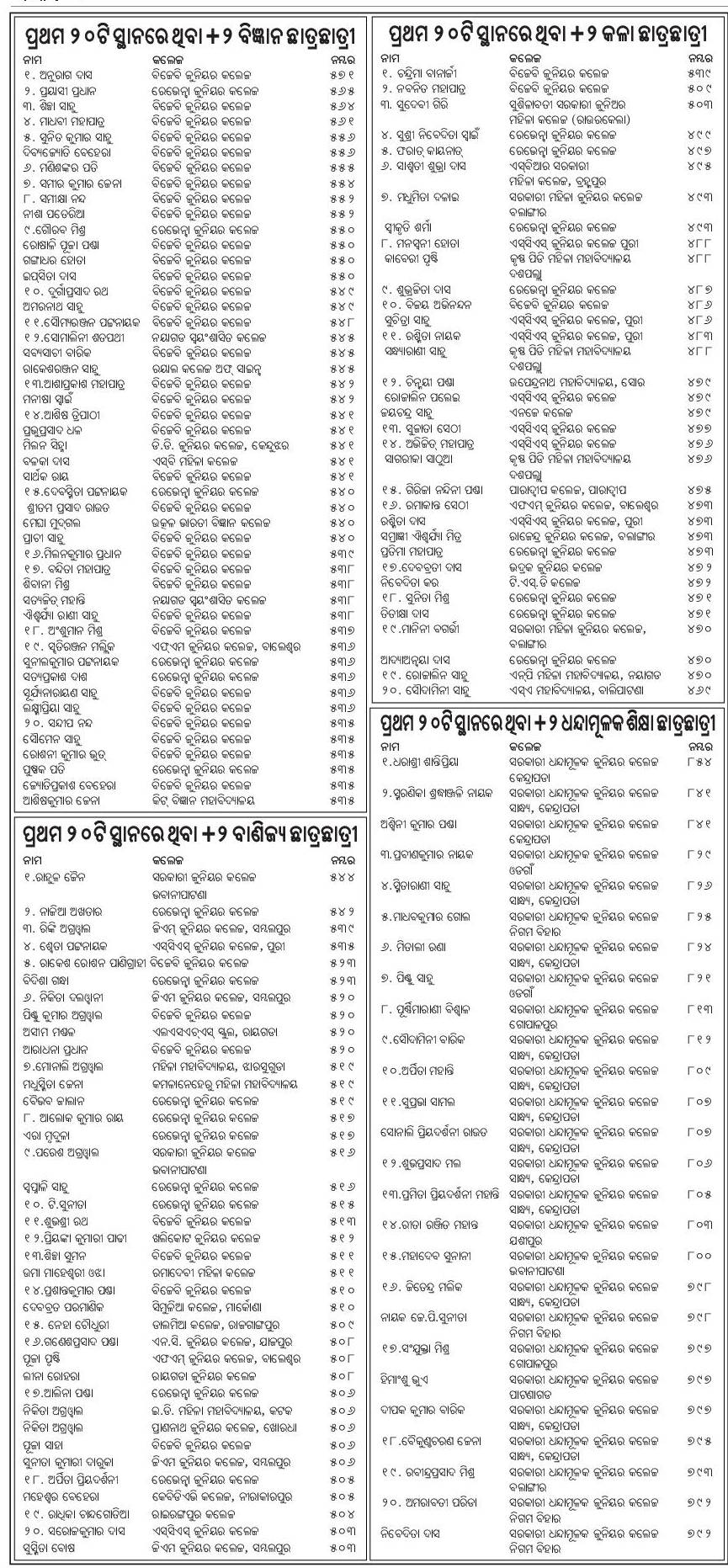
May 28th, 2009
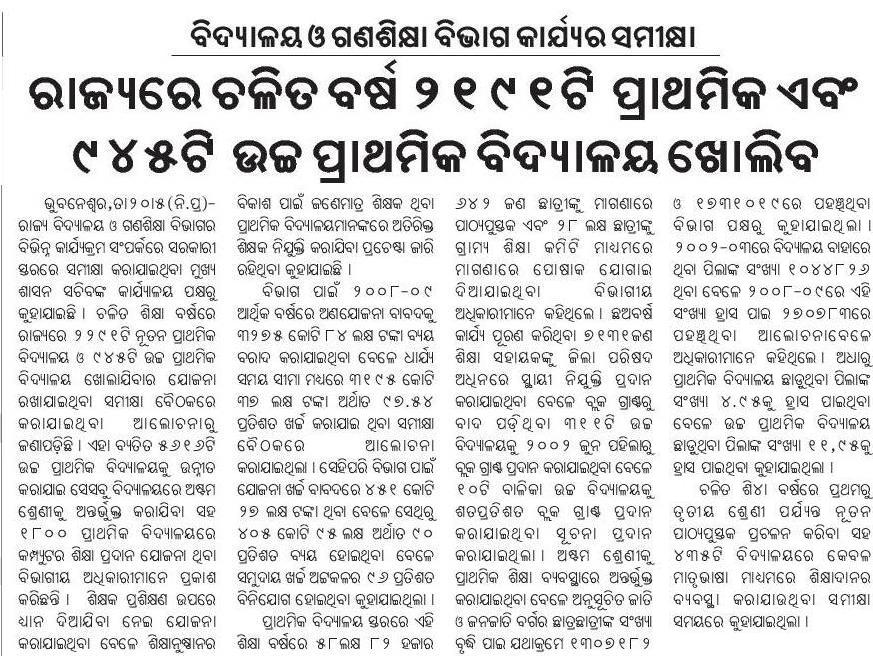
May 21st, 2009
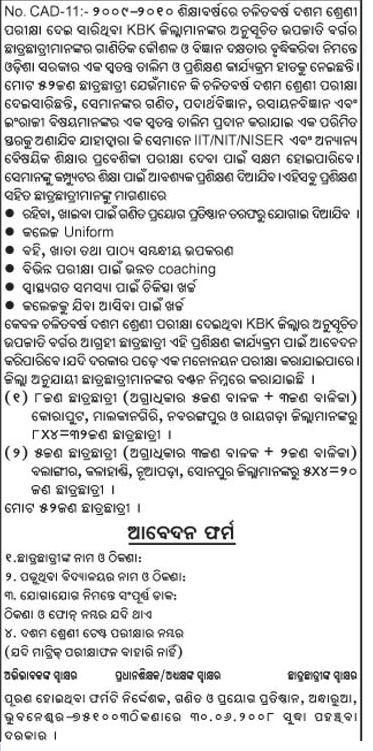
May 14th, 2009
The Department of Higher Education (DHE) of Orissa has a nice new website. This year they are having a joint application for all the +2 government junior colleges and a few private colleges. Following are some links:
- Common Prospectus (pdf). (html)
- Common Application form(pdf).
- Toll Free Number for questions related to the process (it is called e-admission, but I am not sure why): 1 800 345 6770
- Know more about SAMS

- Know more about e-Admission

- Click here for the list of Colleges under SAMS

- Key dates:
- 11-May-09 Downloading CAF & CP from the Website
- 16-Jun-09 Sale of CAF & CP from college counter
- 30-Jun-09 Last date of submission of CAF in any of 60 Junior Colleges
- 12-Jul-09 Publication of FIRST selection list
- 18 & 19 Jul 09 Preliminary Admission of FIRST selection for applicants whose Destination College is different than Applied College
- 20 to 25 Jul-09 Final Admission in Applied-cum-Destination Colleges of First Select List
- 28-Jul-09 Publication of SECOND selection list
- 03-Aug-09 Preliminary Admission of SECOND selection for applicants whose Destination College is other than Applied College
- 4 & 5 Aug 09 Final admission in Applied-cum-Destination Colleges of 2nd Select List
- 6 to 8 Aug 09 Exchange of Documents for outstation college applicants who have taken preliminary admission.
- 10 & 11 Aug 0 Final admission of outstation student in destination colleges
- 12-Aug-09 Classes start for 1st year student (in all 60 Junior Colleges)
The DHE web page has a lot of information including a very nice interactive map of where the government and private colleges are located. Following is a snapshot from that map. The red dots are private aided colleges and the blue dots are government colleges. I have clustered the government colleges to suggest that the government colleges in each cluster can be put together to create a local university.
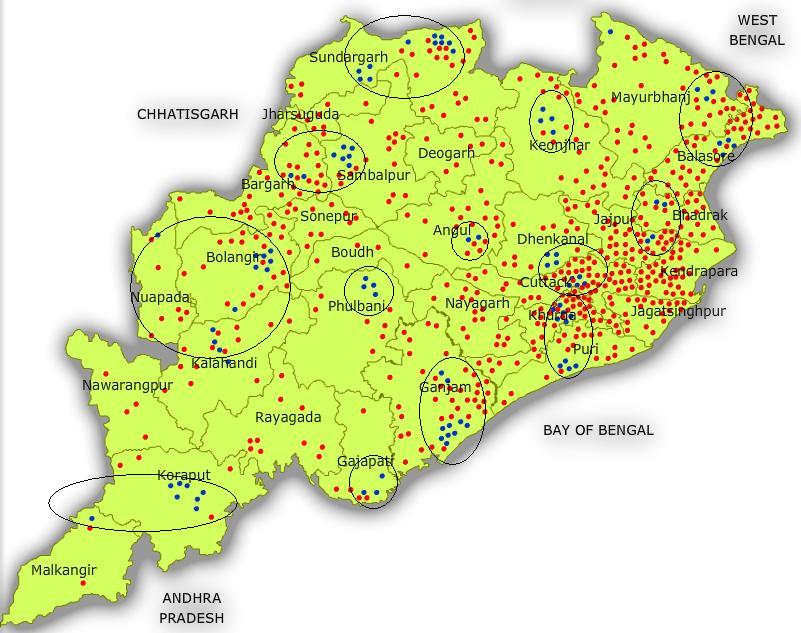
May 13th, 2009
Following is from http://www.iisc.ernet.in/kvpy/about.html.
ABOUT KVPY
The "Kishore Vaigyanik Protsahan Yojana" (KVPY) is a program started during 1999 by the Department of Science and Technology, Government of India to encourage students of Basic Sciences, Engineering and Medicine to take up research careers in these areas. The aim of the program is to identify and encourage talented students with aptitude for research.
This program strives to assist the students to realises their potential and to ensure that the best scientific talent is developed for research and growth in the country. Generous scholarship and contingency grant is provided (up to the Pre-Ph.D. level) to the selected students.
In addition, summer programs for the KVPY Fellows are organised in prestigious research and educational institutions in the country.
The KVPY is funded by the Department of Science and Technology (DST), Government of India. The program is administered by the Indian Institute of Science (IISc, Bangalore), through the overall control of the Chief Executive (SID). The selection of students from those who are studying +1, +2, any U.G. Program including First/Second year Engineering/Medicine are carried out by IISc (Bangalore), IIT-Bombay (Mumbai), and ICMR (New Delhi), respectively, in association with two Zonal Centres one at Kolkata (Indian Institute of Science Education Research, Kolkata) and another at Mumbai (HBCSE, TIFR). There are special groups or committees set up at IISc, IIT and ICMR which screen the applications, conduct interviews at various centres, make the final selection and attend to follow-up matters.
The Department of Science and Technology – the nodal agency of the Government has entrusted the overall responsibility for organising the scheme to the Indian Institute of Science, Bangalore and set up a National Advisory Committee (NAC) for overseeing its implementation. A Basic Committee and a National Scientific Committee has been set up to monitor various aspects, both administrative and academic, of the KVPY Program.
APPLICATION PROCEDURE
Request for Application Form
a. Each Stream has its own application form. Students who wish to apply for more than one Stream should submit separate applications.
b. Applicants may apply either by Hard copy or Online. (http://www.iisc.ernet.in/kvpy).
c. Application forms may be down loaded from the KVPY website. Those who are unable to do so, may request for a Hard Copy.
d. Hard copy of the application form can be obtained from KVPY on request by sending a processing fee of Rs. 200/- (Rs. 100/- for SC/ST) by means of remitting Rs. 200 (Rs. 100/- for SC/ST) “to any core banking branches of STATE BANK OF INDIA, payable at all branches in India. Paid into the credit of Administrative Executive, KVPY A/c. No. 10270577392” and send the “pay-in-slip” along with the request, clearly indicating the stream (i.e.SA, SB, SP etc.) on the envelope
e. The SC/ST – candidates should provide a copy of the caste certificate issued by a competent authority in the prescribed proforma.
f. The completed application form along with the
1. Caste certificate in the case of SC/ST candidate
2. Project report in the case of SP/Basic Sciences/ Engineering/ Medicine
3. copy of the marks statement of the qualifying examination(s), in the case of SP (Engineering), SP(Medicine).
4. The original copy of the challan of processing fee of Rs. 200/- (Rs. 100/- for SC/ST)
should reach KVPY on or before 11.9.09 (Friday).
g. KVPY will not be responsible for postal delays in receiving completed application.
h. Last date for receipt of the request for application form.
| 1. |
By post |
:
|
01 September 2009 |
| 2. |
In person at IISc |
:
|
10 September 2009 |
| 3. |
Last date for receipt of the completed application (both Online/Hard Copy along with cast certificate, project report and processing fee ) |
:
|
11 September 2009 |
All correspondence should be addressed to:
The Convener
Kishore Vaigyanik Protsahan Yojana (KVPY)
Indian Institute of Science
Bangalore 560 012.
May 11th, 2009
NASA organizes a space settlement design contest for high school students and students from all over the world, including from India, participate in it. This year a team from Orissa won the grand prize. The 2009 contest page has this to say about it. (Some name corrections are made using a tathya.in article about this.)
The Grand Prize winning submissions for 2009 went to Eric Yam, Pooja Bhattacharya and Swastika Bhattacharya.
Eric is a student of Ms. Gillian Evans at Northern Secondary School in Toronto Canada. His project was named ASTEN [PDF file 12 MB].
Pooja Bhattacharya and Swastika Bhattacharya were instructed by Ms. Itishree Nanda of St. Xavier’s High School in Orissa India. Orissa Design Inspired Systems and Aerovehicles was the title of their submission.
Following is a list from the page http://www.nas.nasa.gov/About/Education/SpaceSettlement/Contest/ that points to some of the winning proposals.
May 11th, 2009
Mr. Panda has suggested many nice ideas that a school headmaster can easily incorporate. I hope many of them read this article and try to implement at least some of the ideas mentioned in it.
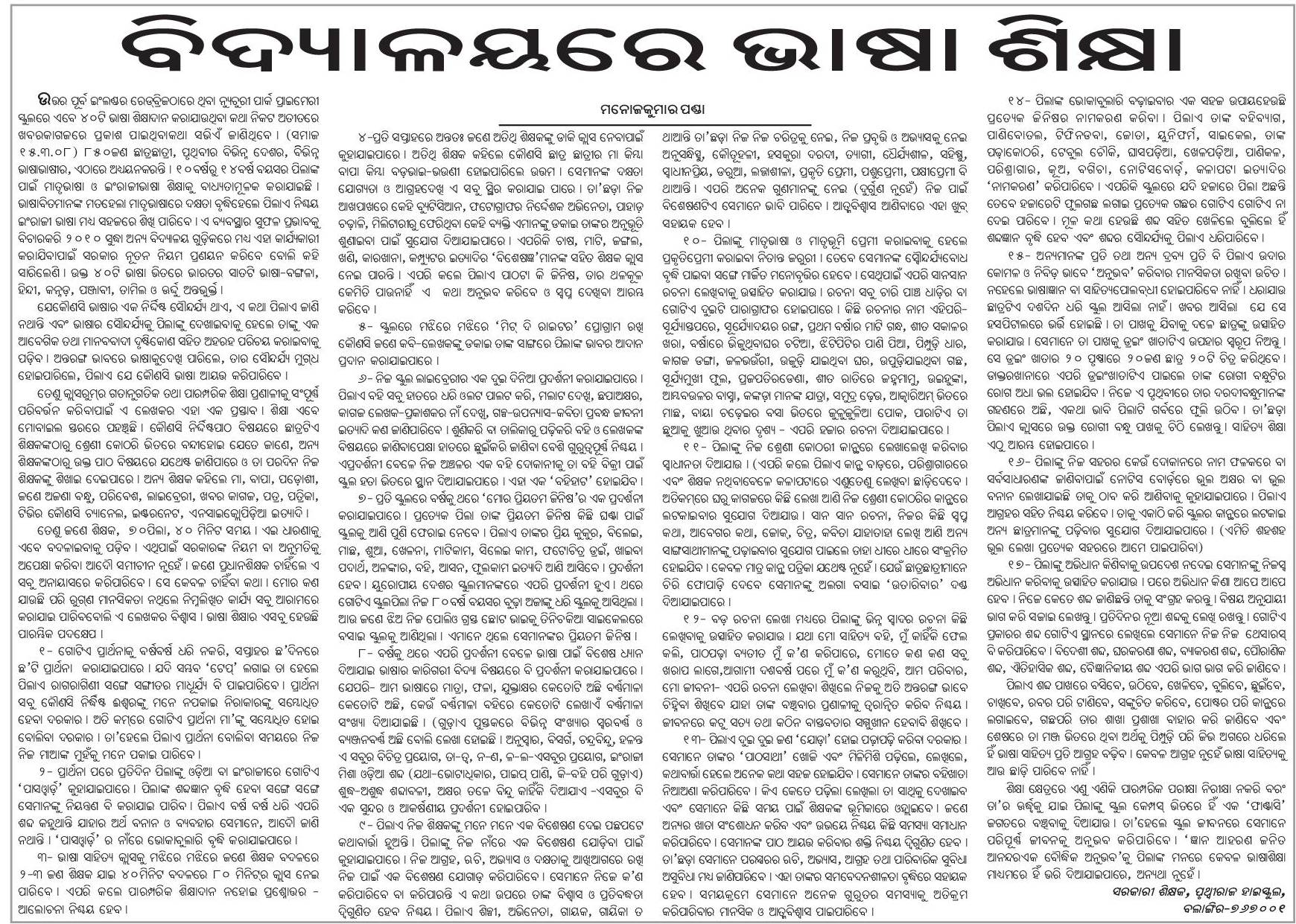
March 23rd, 2009
Following is from a report in the Statesman.
Twelve students of the state including five from DAV Public School, Chandrasekharpur, Bhubaneswar have been selected for the Kishore Vaigyanik Protshana Yojana (KVPY) scholarship. A total of 198 students from across the country have qualified this year.
The students who qualified for the scholarship from DAV Public School, Chandrasekharpur, are ~ Mr Pinaki Prasun Kumar, Mr Biplab Rana, Mr P Dinesh, Mr Rohit Gupta and Mr Smarak Mohanty.
Students of BJB College of Bhubaneswar who qualified for the scholarship are Mr Animesh Swain, Mr Aish Mohapatra and mr Saswat Panigrahi.
Mr Himalaya Senapati of Bhadrak College, Ms Pallabi Mishra from Cuttack Siddharth Senapati and Mr Ajaya Kumar Jena of Balasore have successfully qualified for the scholarship.
The scholarship programme, which is initiated by the Department of Science and Technology, government of India, aims to identify and select students who demonstrate talent and aptitude and encourage and assist them in pursuing research careers. It does so by the means of a two-tire examination.
The successful students will be provided with generous fellowship up to pre-PhD level. In addition, summer programmes in prestigious research and educational institutions in the country will also be organised for them.
February 20th, 2009
Among the 28 central schools for Tibetans, one of them is in Chandragiri of Gajapati district, Orissa. Following is information about that school from this page.
CST Chandragiri is located in the Eastern Ghat region at the height of 1900 feet above sea level, about 250 kilometres away from Bhubaneswar, the capital city of the state of Orissa. The school was established in Phuntsokling Tibetan Settlement in the year 1965 with the blessing of His Holiness the Dalai Lama and managed by Central Tibetan Schools Administration, Delhi, an autonomous body under the Ministry of Human Resource Development, Govt. of India. The school was established to impart modern education and to preserve and promote the rich Tibetan cultural heritage to the children of Tibetan refugees settled in Orissa.
At present the school has two primary school branches, one at Lobersing Camp No. 3 and another at Mahendragarh Camp No. 5 each with a headmaster. The main secondary school at Chandragiri has classes from VI to X. The school has a total strength of 345 students including both the branch schools. Tibetan is the medium of instruction at the primary classes and English in middle and secondary classes. The school is affiliated to the Central Board of Secondary Education (CBSE), Delhi and follows textbooks published by the National Council of Educational Research and Training (NCERT) and CBSE. The total staff strength is 32, which includes 23 teaching staff. The academic performance of the school continues to show improvement and the result of Class X CBSE Board examination held in March 2004 was 92.31% as against 52.77% last year.
The school has good facilities viz. spacious playgrounds, multi-purpose halls, computer lab, senior & junior science labs, audio-visuals, resource centre, library, OHP, art and tailoring sections. The Settlement Officer and Parent-Teacher Association take active interest in the development of the school.
January 29th, 2009
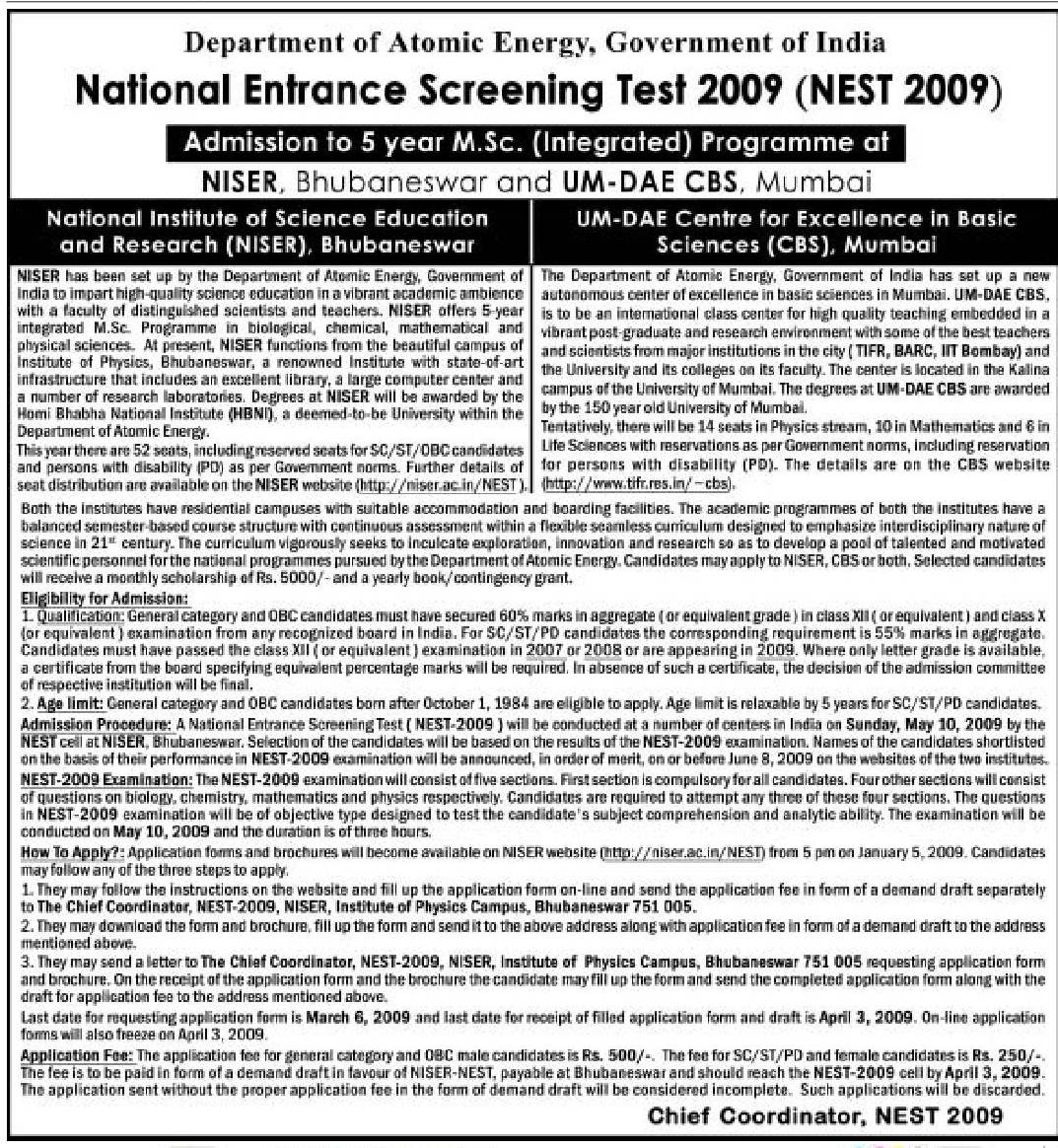
Unlike the IISERs that take students from the IIT exams and KVPY, NISER Bhubaneswar (an IISER-equivalent institute that is funded by DAE) teams up with UM-DAE and has its own exam called NEST. (They also took students from KVPY.)
The following information regarding NEST 2009 is from http://niser.ac.in/NEST/.
About NEST
National Entrance Screening Test (NEST) is a compulsory test for students seeking admission to National Institute of Science Education and Research (NISER), Bhubaneswar and University of Mumbai – Department of Atomic Energy Centre for Excellence in Basic Sciences (UM-DAE CBS), Mumbai. Both NISER and UM-DAE CBS have been started by Department of Atomic Energy, Government of India in 2007. Their mandate is to train scientific manpower for carrying out cutting edge scientific research and for providing input to scientific programs of Department of Atomic Energy and other applied science institutions in the country. The test is conducted in more than 25 centers across India. This brochure gives the detailed procedure for applying for the test, syllabus of the test and various dead lines.
NEST Brochure 
About NISER
NISER has been set up by the Department of Atomic Energy, Government of India to impart high-quality science education in a vibrant academic ambience with a faculty of distinguished scientists and teachers. NISER offers 5-year integrated M.Sc. programme in biological, chemical, mathematical and physical sciences. At present, NISER functions from the beautiful campus of
Institute of Physics, Bhubaneswar, a renowned Institute with state-of-art infrastructure that includes an excellent library, a large computer center and a number of research laboratories. Degrees at NISER will be awarded by the Homi Bhaba National Institute (HBNI), a deemed-to-be University within the department of Atomic energy.
This year there are 52 seats, including reserved seats for SC/ST/OBC candidates and persons with disability (PD) as per Government norms. Further details about the institute can be found on the NISER website (http://niser.ac.in).
NISER Brochure 
About UM-DAE CBS
The Department of Atomic Energy, Government of India has set up a new autonomous center of excellence in basic sciences in Mumbai. UM-DAE CBS, is to be an international class center for high quality teaching embedded in a vibrant post-graduate and research environment with some of the best teachers and scientists from major institutions in the city (TIFR, BARC, IIT Bombay) and the University and its colleges on its faculty. The center is located in the Kalina campus of the University of Mumbai. The degrees at UM-DAE CBS are awarded by the 150 year old University of Mumbai.Tentatively, there will be 14 seats in Physics stream, 10 in Mathematics and 6 in Life Sciences with reservations as per Government norms, including reservation for persons with disability (PD). The details are on the CBS website (http://www.tifr.res.in/~cbs).
Important Dates
- Last date for request of application form : March 6, 2009
- Last date for receipt of completed application form with DD : April 3, 2009
- Online applications freeze : April 3, 2009
- Dispatch of offline admit cards begins : April 15, 2009
- Download of online admit cards begins : April 15, 2009
- Date of examination : May 10, 2009 (Sunday), 1 pm to 4 pm
- Announcement of results on NEST website : June 8, 2009
Eligibility for appearing NEST
Students securing at least 60% marks in aggregate (or equivalent grade) in Class XII (or equivalent) examination from any recognized Board in India are eligible to apply. For Scheduled Cast (SC), Scheduled Tribes (ST) candidates and for Persons with Disability (PD), the minimum requirement is 55%. Students who have passed the Class XII qualifying examination in 2007 or 2008 or are appearing in 2009 are eligible to apply. (Where only Letter grade is given by the Board, a certificate from the Board specifying equivalent percentage marks will be required. In the absence of such a certificate the decision of the respective Admissions Committee will be final.)
How to apply (3 ways)
- Online form submission is the most convenient and preferred way. Follow these steps to go for it.
- Register yourself before you login.
- Confirm your registration from a mail sent to you just after registration.
- Login in the NEST homepage with your mail-id and password.
- Fill the form and save it or, modify an already saved form.
- Take the print-out and send along with DD.
- Form can be downloaded, filled and sent back with DD. Download form NEST Brochure Please set margin in the browser page-setup to accomodate the form in a single A4 sheet.
- A letter of request can be sent to get the printed form by post. This form will have to be sent back along with DD after filling it properly.
January 13th, 2009
Following is from http://pib.nic.in/release/release.asp?relid=46321.
The CCEA today approved the implementation of a centrally sponsored scheme to universalise access to and improve quality of education at Secondary stage, called Rashtriya Madhyamik Shiksha Abhiyan (RMSA) during the 11th Five Year Plan.
As regards the Financing pattern and fund flow, Union Government shall bear 75% of the project expenditure during the 11th Five Year Plan, with 25% of the cost to be borne by State Governments. Sharing pattern will be 50:50 for the 12th five year plan. For both the 11th and 12th Plans, funding pattern will be 90:10 for North Eastern States. Rs.20,120 crore has been allocated for the Scheme during the 11th Five Year Plan.
The objective of the Scheme is:
• to achieve a General Enrolment Ratio (GER) of 75% for classes IX-X within 5 years by providing a secondary school within a reasonable distance of every habitation;
• to improve quality of education imparted at secondary level through making all secondary schools conform to prescribed norms;
• to remove gender, socio-economic and disability barriers, Universal access to secondary level education by 2017, i.e. by the end of 12th Five Year Plan and Universal retention by 2020.
Broad physical targets include improving the enrolment ratio for classes IX-X to 75% within 5 years from 52.26% as in 2005-06, providing facilities for estimated additional enrolment of 32.20 lakh by 2011-12 through, strengthening of about 44,000 existing secondary schools, opening 11,188 new secondary schools, appointment of 1.79 lakh additional teachers and construction of 80,500 additional classrooms.
Interventions approved include providing infrastructure in schools such as new classrooms with furniture, library, science laboratory, computer room, disabled friendly provisions etc, recruitment of additional teachers with emphasis on Science, Mathematics and English teachers, in service training of teachers, teaching aids such as ICT and special focus on SC/ST/Minorities Girls. Steps such as priority for opening or upgradation of schools in areas of SC/ST/minority/weaker section concentration and enrolment drives and special coaching classes in those areas are also envisaged under the scheme.
The Scheme will be implemented in a Mission mode, with a National Mission headed by the Union Minister for HRD and a Project approval Board headed by Secretary (School Education and Literacy) to appraise and approve state plans. Similarly, State Missions under Chief Ministers of the States/UTs will be set up.
The Scheme envisages development of State-specific norms and District will be the unit of planning. The district plan will be appraised and consolidated at the State level and the State plan will be appraised by the technical support group attached to the National Mission. The civil construction will be through School Management and Development Committee with representation from parents, Panchayati Raj Institutions and civil society.
*****
AD/SH/LV
January 3rd, 2009
Update2: The number 80,000 is inconsistent with the earlier announced number of Rs 100,000/year made in http://pib.nic.in/release/release.asp?relid=36632.
Update: See also http://www.pib.nic.in/release/release.asp?relid=45626 for the PM’s speech while launching the INSPIRE program.
Following is from a report in Telegraph.
India’s brightest students who choose to pursue science in college will get Rs 80,000 a year under a government scholarship to draw youngsters to careers in research.
The department of science and technology (DoT) today launched the nation’s largest-ever project to wean high-school students away from dreams of studying engineering or medicine towards BSc and MSc degrees.
Students who rank within 10,000 in the IIT Joint Entrance Examination and within 20,000 in the All India Engineering Entrance Examination but still choose BSc will be eligible for the scholarship, announced earlier this year but formally launched by Prime Minister Manmohan Singh today. Students who clear the central medical entrance exam but opt for BSc will also be eligible.
All students who come within the top 1 per cent both in the 10th and 12th standard exams of central or state boards may also apply for the Scholarship for Higher Education. The department of science expects to offer 10,000 scholarships every year.
Students of Indian Institutes of Science Education and Research (IISERs) and the National Institute of Science Education and Research (NISER), national science talent scholars and Olympiad medallists will also be eligible.
The scholarship will be available from BSc second year till the students complete their master’s. Students of IISER Pune, Calcutta, Mohali, Bhopal and Thiruvananthapuram will receive it this year. So will those of NISER Bhubaneswar.
… The project will also award Rs 5,000 every year to 200,000 students from classes VI to X — picked with help from the schools’ science faculties — for work on a school-level science project. It will provide doctoral fellowships and an assured five-year research career to postgraduate students.
The government will spend Rs 2,100 crore on the scheme in the next three years.
India’s science policy makers have long worried about the migration of meritorious students towards, traditionally, engineering and medicine and, in recent years, management and information technology. “This initiative is important for India from a long-term perspective,” said T. Ramasamy, DoT secretary. “We expect to begin seeing gains from this in about a decade or so from now.”
December 14th, 2008
Next Posts
Previous Posts








